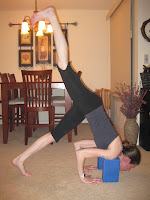Hi everyone! As many of you already know from attending my classes, I like to add a challenge pose to each class that we break down and work on. The entire class is dedicated to that pose in many different ways: warming up the body properly, opening in the areas that will allow us to come into and hold our challenge pose, and working on the alignment necessary to come into the pose safely. As a way to provide all the yogis out there with take-home notes on the challenge pose of the week I am going to start posting them here. You will find a picture of the pose(s) being presented and the break down of how to do it, things to look out for, and key points to remember. As always, if you have any questions feel free to write me at info@PamelaNixon.com
This week are working on back bends. When you stop and think about it, we don't spend very much time in positions that cause us to arch backwards. We spend a lot of time bending over to pick things up, hunched over a desk or a computer, or curled up in a forward fold while we sleep. The position we put our body in can have a great effect on how we feel. When we are slouched forward with our shoulders dropping down and our chin tucked to our chest doesn't exactly make us feel cool, calm and confident, does it? Back bending, when done correctly, can can be very rejuvenating and energizing and have a positive effect on our emotions, our outlook and our state of mind! Think about what happens in a back bending pose: your chest and heart are lifted, your shoulders are back and you feel open and free!
This weeks back bend challenge poses are Natarajasana (king dancer pose) using a strap, and a variation of Ganda Bherundasana (formidable face poses) using blocks for support. Lets look at each one and break them down step by step!
Ganda Bherundasana
Step 1. Set your blocks up so they are shoulder width apart, then come into down dog with your finger tips behind the blocks.
Step 2. Shift forward into plank then lower to chaturanga with your shoulders resting on the blocks. Keep your core engaged and hips lifted slightly so there is no sinking in the low back. If your blocks are low enough your chin may rest on the floor. Do not put a lot of weight into the chin. Let the weight be in the hands and blocks.
Step 3. Walk your feet in towards your hands so your bottom is sticking up in the air like an inchworm. If your blocks are upright your chin will not reach the floor. If they are turned down and your chin is on the floor be careful not to sink weight into the chin which will put pressure on the cervical spine.
Step 4. Practice lifting one leg up into the air and hold here, then switch legs.
Step 5. When you feel ready you can take practice hops, or kick up so that both legs are extended up into the air. Keep pressing the hands down and avoid letting the elbows widen out to the side.
Natarajasana
Step 1: Make a large loop with your strap and place it in your right hand. Bend your right knee and place the strap around the right foot behind you. Rotate your elbow in, out, and up so that your holding the strap over your head and your elbow points forward. Hug the elbow in towards your ear.
Step 2: Reach the left arm up, bend the elbow and take hold of the strap in the left hand as well as the right. Both arms are bent, elbows are pointing forward. Hug the elbows in towards the ears and resist them falling out to the sides.
Step 3: Press the foot back into the strap, lift the knee a little higher away from the floor, walk the hands down the strap a little further. Keep repeating those 3 movements until you have found a comfortable place to stop. Tuck the tailbone to lengthen the curve in the low back and keep the elbows in. Keep pressing down through the left foot for balance. Feel the chest open and expand.
If you feel any discomfort in the low back during back bending, try tucking the tailbone a bit more so that you can relieve some pressure. If this doesn't help, back out of the pose a bit until you find a place that is comfortable for you. Your breath is a good indicator of whether or not you have gone too far. If your breath becomes agitated you may have gone too far. Be sure to work your way into back bends slowly so that you have the opportunity to recognize any messages your body is sending to you and always listen when your body says stop.








No comments:
Post a Comment